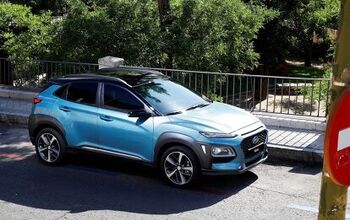Hyundai's Subcompact Crossover Has a Name: 'Kona'

After its skyrocketing post-recessions sales hit a roadblock in the United States, Hyundai can’t wait to sell Americans more crossovers. It just needs to build them first.
While the Korean automaker already has plans to tinker around with its existing utility lineup, it lacks product on the small end of the scale, which currently gives rivals an edge.
Well, not for long.
Today, Hyundai revealed the name that will soon join the subcompact CUV fray — Kona. Overseas markets will see the Kona in the second half of this year, but those all-important U.S. buyers will have to wait just a little while longer.
If you’re familiar with Hawaii, you’ll know the Kona name isn’t derived from anything Korean. A district on the west coast of the Big Island, Kona sounds like paradise to anyone who has to suffer through windshield scraping and block heater repair. It also sounds very global, key for a mass-market model.
Hyundai furnished us with a teaser image, but there’s not much else to go on besides Hyundai’s claim that the Kona will arrive with “bold, striking design and high interior refinement and spaciousness” — something we’ve heard about every product from every automaker. You’re guaranteed narrow LED headlights, folks.
Contrary to early reports, there won’t be a Kona at the New York Auto Show. According to Derek Joyce, Hyundai Motor America’s product public relations manager, the automaker plans to use the venue to get buyers interested in the refreshed 2018 Sonata.
“At this time, we can only confirm the Kona name and that it will compete with other B-segment CUVs, broadening Hyundai’s impressive CUV line-up,” said Joyce. “Kona will launch in the Korean domestic market in the summer of 2017 and in the U.S. market in early 2018.”
Product details should be available in the near future, he told TTAC.
With Ford targeting the U.S. with its overseas-market EcoSport and Toyota entering the B-segment game with its C-HR, Hyundai needs a product to rebuff those models, as well as Mazda’s CX-3 and Honda’s H-RV. An A-segment CUV could follow the Kona, but that market isn’t nearly as important. Meanwhile, Hyundai plans to grow the Tucson and Santa Fe Sport slightly, with the range-topping Santa Fe due for eight-passenger capacity and a name change.
[Image: Hyundai Motors]

More by Steph Willems
Latest Car Reviews
Read moreLatest Product Reviews
Read moreRecent Comments
- Jalop1991 is this anything like a cheap high end German car?
- HotRod Not me personally, but yes - lower prices will dramatically increase the EV's appeal.
- Slavuta "the price isn’t terrible by current EV standards, starting at $47,200"Not terrible for a new Toyota model. But for a Vietnamese no-name, this is terrible.
- Slavuta This is catch22 for me. I would take RAV4 for the powertrain alone. And I wouldn't take it for the same thing. Engines have history of issues and transmission shifts like glass. So, the advantage over hard-working 1.5 is lost.My answer is simple - CX5. This is Japan built, excellent car which has only one shortage - the trunk space.
- Slavuta "Toyota engineers have told us that they intentionally build their powertrains with longevity in mind"Engine is exactly the area where Toyota 4cyl engines had big issues even recently. There was no longevity of any kind. They didn't break, they just consumed so much oil that it was like fueling gasoline and feeding oil every time


































Comments
Join the conversation
Kona bicycles is still in business - did Hyundai have to pay them anything to use the name? Or is it a non-issue, since these are cars? Also, remember the Kona Edition Focus, that came with a bike rack, and a Kona bike? I still see one of those occasionally.
Guess Ford has to change the name of their dark blue paint...